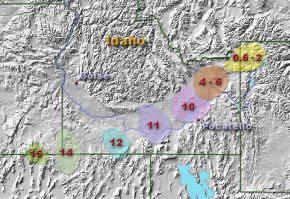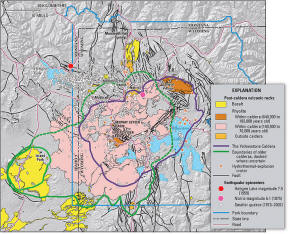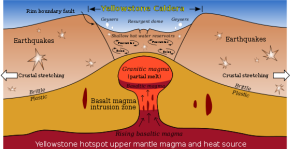Volcanism
Yellowstone, like Hawaii, is believed to lie on top of an area called a hotspot where light, hot, molten mantle rock rises towards the surface. While the Yellowstone hotspot is now under the Yellowstone Plateau, it previously helped create the eastern Snake River Plain (to the west of Yellowstone) through a series of huge volcanic eruptions. Although the hotspot's apparent motion is to the east-northeast, the North American Plate is really moving west-southwest over the stationary hotspot deep underneath.
Over the past 17 million years or so, this hotspot has generated a succession of violent
 |
| Path of the Yellowstone hot spot over the past 15 million years. |
The oldest identified caldera remnant straddles the border near McDermitt, Nevada-Oregon, although there are volcaniclastic piles and arcuate faults that define caldera complexes more than 60 km (37 mi) in diameter in the Carmacks Group of southwest-central Yukon, Canada, which is interpreted to have formed 70 million years ago by the Yellowstone hotspot. Progressively younger caldera remnants, most grouped in several overlapping volcanic fields, extend from the Nevada-Oregon border through the eastern Snake River Plain and terminate in the Yellowstone Plateau. One such caldera, the Bruneau-Jarbidge caldera in southern Idaho, was formed between 10 and 12 million years ago, and the event dropped ash to a depth of one foot (30.48 cm) 1,000 miles (1,600 km) away in northeastern Nebraska and killed large herds of rhinoceros, camel, and other animals at Ashfall Fossil Beds State Historical Park. Within the past 17 million years, 142 or more caldera-forming eruptions have occurred from the Yellowstone hotspot.
The loosely defined term 'supervolcano' has been used to describe volcanic fields that produce exceptionally large volcanic eruptions. Thus defined, the Yellowstone Supervolcano is the volcanic field which produced the latest three supereruptions from the
 |
| Yellowstone sits on top of three overlapping calderas. (USGS) |
Non-explosive eruptions of lava and less-violent explosive eruptions have occurred in and near the Yellowstone caldera since the last supereruption. The most recent lava flow occurred about 70,000 years ago, while the largest violent eruption excavated the West Thumb of Lake Yellowstone around 150,000 years ago. Smaller steam explosions occur as well; an explosion 13,800 years ago left a 5 kilometer diameter crater at Mary Bay on the edge of Yellowstone Lake (located in the center of the caldera). Currently, volcanic activity is exhibited via numerous geothermal vents scattered throughout the region, including the famous Old Faithful Geyser, plus recorded ground swelling indicating ongoing inflation of the underlying magma chamber.
The volcanic eruptions, as well as the continuing geothermal activity, are a result of a great cove of magma located below the caldera's surface. The magma in this cove contains gases that are kept dissolved only by the immense pressure that the magma is under. If the pressure is released to a sufficient degree by some geological shift, then some of the gases bubble out and cause the magma to expand. This can cause a runaway reaction. If the expansion results in further relief of pressure, for example, by blowing crust material off the top of the chamber, the result is a very big gas explosion.
Earthquakes
Due to the volcanic and tectonic nature of the region, the Yellowstone Caldera experiences between 1000 and 2000 measurable earthquakes a year, though most are relatively minor, measuring a magnitude of 3 or weaker. Occasionally, numerous earthquakes are detected in a relatively short period of time, an event known as an earthquake swarm. In 1985, more than 3000 earthquakes were measured over several months. More than 70 smaller swarms have been detected between 1983 and 2008. The USGS states that these swarms could be caused more by slips on pre-existing faults than by movements of magma or hydrothermal fluids.
In December 2008, continuing into January 2009, more than 500 quakes were detected under the northwest end of Yellowstone Lake over a seven day span, with the largest registering a magnitude of 3.9. The most recent swarm started after the January 2010 Haiti earthquake. With 1620 small earthquakes between January 17, 2010 and February 1, 2010, this swarm was the second largest ever recorded in the Yellowstone Caldera. The largest of these shocks was a magnitude 3.8 on January 21, 2010 at 11:16 PM MST. This swarm reached the background levels by 21st of February.
Volcanic Hazards
The last full-scale eruption of the Yellowstone Supervolcano, the Lava Creek eruption
 |
| Diagram of the Yellowstone Caldera |
Geologists are closely monitoring the rise and fall of the Yellowstone Plateau, which measures on average 0.6 inches (1.5 cm) yearly, as an indication of changes in magma chamber pressure.
The upward movement of the Yellowstone caldera floor—almost 3 inches (7.6 cm) each year between 2004 and 2008—was more than three times greater than ever observed since such measurements began in 1923.From mid-Summer 2004 through mid-Summer 2008, the land surface within the caldera moved upwards, as much as 8 inches (20 cm) at the White Lake GPS station. By the end of 2009, the uplift had slowed significantly and appeared to have stopped. In January 2010, the USGS stated "that uplift of the Yellowstone Caldera has slowed significantly" and uplift continues but at a slower pace. The U.S. Geological Survey, University of Utah and National Park Service scientists with the Yellowstone Volcano Observatory maintain that they "see no evidence that another such cataclysmic eruption will occur at Yellowstone in the foreseeable future. Recurrence intervals of these events are neither regular nor predictable."
Hydrothermal Explosion Hazard
Studies and analysis may indicate that the greater hazard comes from hydrothermal activity which occurs independently of volcanic activity. Over 20 large craters have been produced in the past 14,000 years, resulting in such features as Mary Bay, Turbid Lake, and Indian Pond.
Lisa Morgan, a USGS researcher, explored this threat in a 2003 report, and in a recent talk postulated that an earthquake may have displaced more than 77 million cubic feet (2,200,000 m3) (576,000,000 US gallons) of water in Yellowstone Lake, creating colossal waves that essentially unsealed a capped geothermal system leading into the hydrothermal explosion that formed Mary Bay.
Further research shows that earthquakes from great distances do reach and have effects upon the activities at Yellowstone, such as the 1992 7.3 magnitude Landers earthquake in California’s Mojave Desert that triggered a swarm of quakes from more than 800 miles (1,300 km) away and the Denali fault earthquake 2,000 miles (3,200 km) away in Alaska that altered the activity of many geysers and hot springs for several months afterwards.
The head of the Yellowstone Volcano Observatory, Jake Lowenstern, has proposed major upgrades and extended monitoring since the U.S. Geological Survey classified Yellowstone as a “high-threat” system.
Origin
The source of the Yellowstone hotspot is controversial. Some geoscientists hypothesize that the Yellowstone hotspot is the effect of an interaction between local conditions in the lithosphere and upper mantle convection. Others prefer a deep mantle origin (mantle plume). Part of the controversy is due to the relatively sudden appearance of the hotspot in the geologic record. Additionally, the Columbia Basalt flows appeared at the same approximate time, causing speculation about their origin.
End of Reading
Return to the Old Earth Ministries Online Earth History Curriculum homepage.
Source: Yellowstone Caldera